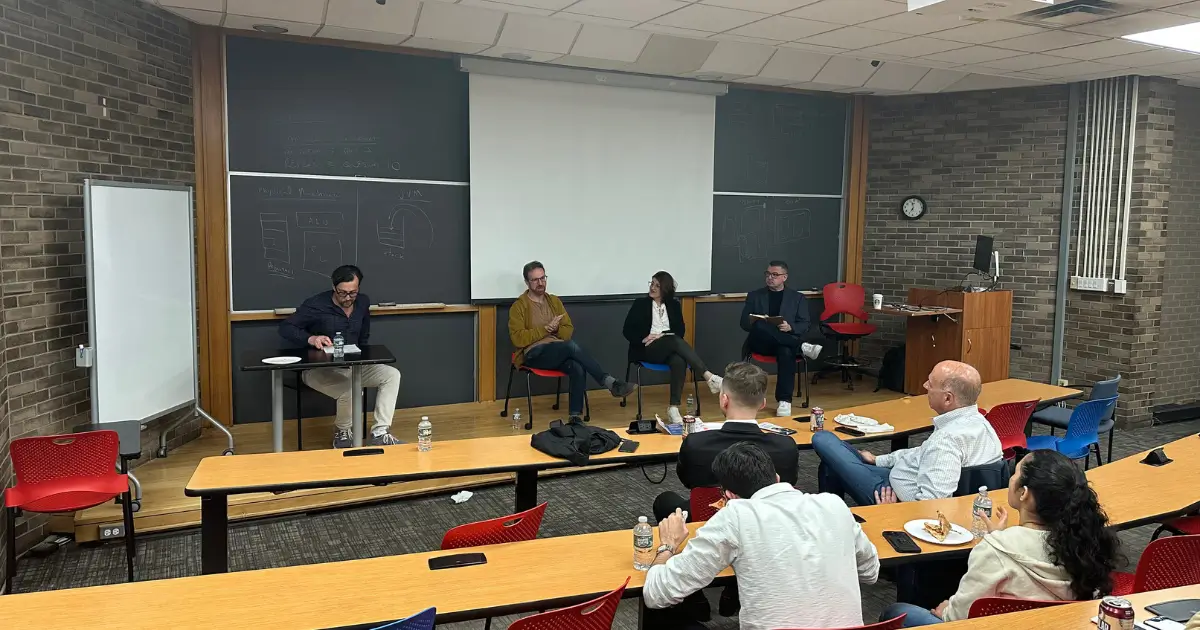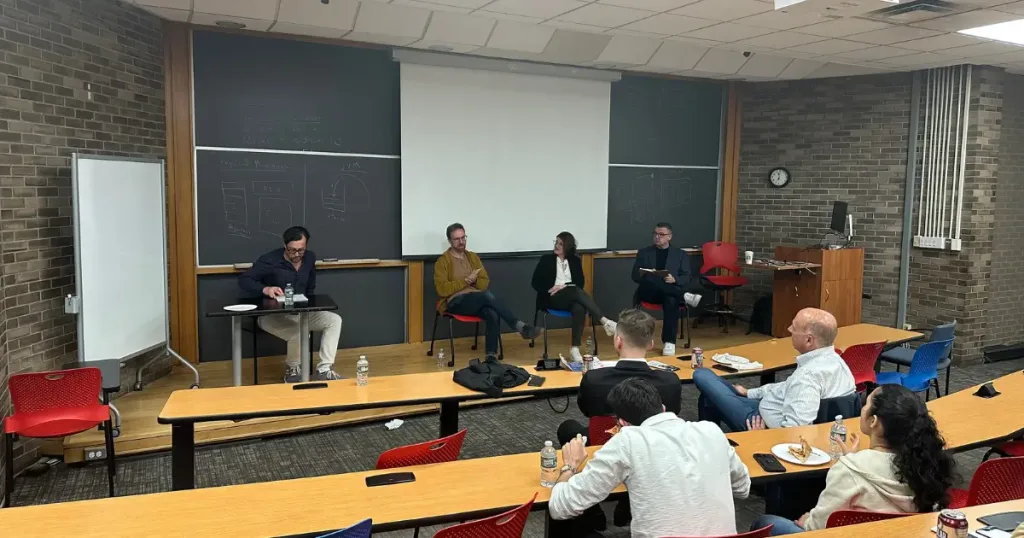Effective remote team collaboration hinges on strong leadership strategies, fostering a positive team culture, and clear communication. This article explores key tactics to enhance team performance in a distributed environment, including setting clear goals for teams, measuring team effectiveness, and improving employee engagement. Learn how to unlock the full potential of your remote team and achieve success!
[ez-toc]
About Our Pannel of Experts
Creating high-performing teams has become more critical and complex than ever; remote work environments seems to require an extra a layer of preparation. But does it, really?
In the recent Connecting the Americas roundtable, three tech leaders brought in their expertise in building high-performance distributed teams:
- Dave Kaplan (CTO of Alma): cultural leadership, operational practices, high performing teams.
- Scheila Farias (Latam Talent Expert at Ubiminds): recruiting staff, and developing and fostering high performing teams.
- Randy Shepherd (former CTO of Giphy): a combination of technology, product, organizational design, and working with motives. Again, high performing teams.
Together, they offered invaluable perspectives on team leadership, organizational design, and fostering a collaborative culture. Here are the key takeaways from their discussion:
1. Defining High-Performing Teams
A high-performing team is more than just a group that meets its objectives—it’s a cohesive unit that continuously strives for excellence, improves processes, and aligns its efforts with both business goals and shared values, fostering a strong team culture.
Exceeding Business and Non-Commercial Goals
A high-performing team consistently surpasses its objectives, whether in commercial goals such as revenue growth, or non-commercial goals like customer satisfaction and Net Promoter Scores (NPS). Dave Kaplan noted the importance of using modern engineering metrics, such as the DORA Metrics, to track the speed and quality of deployments.
“You know you’ve got a high-performing team when they aren’t held back by churn. They don’t spend time talking about how they work anymore—they’re laser-focused on solving business problems.” — Dave Kaplan
Randy stressed the importance of establishing regular communication through company-wide goals, OKRs, and one-on-one reviews to maintain focus. According to Randy, this structured communication helps technical teams remain product-oriented and ensures they focus on business outcomes rather than just technical metrics.
“At Giphy, we constantly framed everything in terms of what it meant for the product and our users.” – Randy Shepherd
Moreover, high-performing teams excel in navigating complexity. They understand when to invest time in tackling technical debt versus developing new features or addressing bug fixes, aligning their decisions with long-term business value. Randy elaborated on the importance of self-organization in prioritizing these tasks:
“It’s not just about keeping the engine running—it’s about continually refining how we deliver value to the customer while balancing technical needs.” — Randy Shepherd
By fostering this balance, high-performing teams are able to not only meet but exceed both immediate and future goals, ensuring scalability and resilience in the face of challenges.
Continuous Improvement
Albeit Measuring team performance is essential for identifying areas of growth and ensuring that teams stay aligned with overall business objectives, the three of them warned against an over-reliance on productivity metrics like lines of code or code reviews. To them, they often lead to “gaming the system” rather than delivering real value. Instead, the focus should be on outcomes.
As nuance, Scheila pointed out the challenge many teams face in balancing efficiency (doing more with fewer resources) and effectiveness (solving user problems well). High-performing teams manage to blend both:
“We’re talking not only about doing more with less — that’s effort, not result. High performance is about doing the RIGHT things well, and the right thing will depend on what your unique selling proposition is and what you promised as a brand to your user, to your customer.” — Scheila Farias
To Randy, it goes back to balancing technical goals with business outcomes:
“Focusing on outcomes is the way to sidestep all that noise. You understand the business problems that need solving, and you set clear objectives with the team. Then, let them figure out how best to achieve those goals.” — Randy Shepherd
By shifting the focus to meaningful results, leaders can foster greater autonomy within their teams, allowing them to choose the best approaches to meet their objectives.
“There are two parallel tracks here: delivering what the business needs and continually improving how we do that.” — Randy Shepherd
Through this, the team isn’t just hitting its goals but constantly refining how it works, striving for both efficiency and effectiveness.
2. Leadership Strategies for Building High-Performing Teams
Building high-performing teams requires more than just meeting objectives; it’s about effective team leadership and fostering an environment where team members feel empowered, valued, and aligned with the company’s goals.
1. Setting Clear Vision and Context
Leaders need to establish a long-term vision and provide context for the team’s work. When team members understand the bigger picture and how it relates to their roles, they are more likely to stay motivated and perform better, which is crucial for improving team communication.
However, it’s crucial to recognize that traditional metrics, such as code commits and the number of tickets pushed, often fail to reflect the true performance and impact of a team.
“Measuring output can lead to a race for quantity over quality. We need to shift our focus to the impact our work has on users and the business as a whole.” — Scheila Farias“
Focusing solely on output can create a misleading narrative about a team’s effectiveness. For example, a high number of code commits does not necessarily equate to high-quality work or progress toward strategic goals. Instead, leaders should prioritize outcomes that align with business objectives. This shift in perspective allows teams to concentrate on delivering meaningful results that solve real problems for users, rather than just ticking off tasks on a checklist.
“It’s about understanding the ‘why’ behind what we do. When teams know how their work impacts the broader goals, they become more engaged and purposeful.” — Dave Kaplan
By providing clarity around expected outcomes, leaders can foster an environment where team members feel empowered to innovate and explore solutions that drive value.
This outcome-driven approach encourages teams to think critically about their work and ensures that their efforts contribute to the organization’s overall success.
2. Operationalizing Goals and Removing Roadblocks
Effective team leadership is vital to operationalizing goals and ensuring efficient execution across remote teams.
Once a clear vision is set, leaders must translate this vision into actionable goals and implement processes to ensure efficient execution. You can let the team decide on what to do, how and when – the leader is there simply to calibrate these suggestions.
“If you’re a technology leader, you have a pretty good idea of how hard things are, give or take an error factor of 25%. You understand the business problems that you need to solve. You know the timelines that need to be solved in, and then you can present all that to the team.” — Randy Shepherd
From there on, it’s about negotiating and removing operational obstacles that hinder progress.
“You set the North Star, you give them context, and then you remove roadblocks—anything that hinders the team’s focus on their goals.” — Randy Shepherd
To Scheila, distributed work is actually a huge plus when it comes to collaborating across time and space.
“One of the pros of having people spread out is that they didn’t have so much problem with legacy from there forward. They were writing cleaner code, and the team had to document it better because they didn’t have the face-to-face time,” – Scheila Farias
This shift not only enhanced code quality but also fostered accountability within teams, as members learned to rely on clear documentation to support their work. A great example of how remote work environment presents unique opportunities for teams to thrive.
Dave highlighted the significance of effectiveness and trust within teams, asserting,
“We had high accountability and we had all these check-ins. We weren’t spying on people. Just by having that level of accountability, it just wasn’t a problem.” – Dave Kaplan
This emphasis on accountability fosters an environment where team members feel empowered to make decisions, reducing the need for micromanagement. Less overbearing yet critical to managing remote teams effectively.
3. Fostering a Generative Culture
Dave Kaplan introduced the idea of a generative culture, where team members feel empowered to make decisions and own their work. This is not simply about delegating tasks but fostering a collaborative and trust-driven environment.
“In a generative culture, the team makes real, consequential decisions. It’s not enough to just say ‘you’re empowered’—you have to build that into the behavior and mindset of the team.” — Dave Kaplan
A key aspect of this culture is the establishment of safe spaces, particularly for junior developers. Scheila highlighted that team members can’t struggle with asking for help due to fear of embarrassment. For example:
“Our juniors had to be safe for error. They couldn’t be embarrassed about saying they didn’t know something or that they needed help. They would have to ask for help because otherwise nobody would guess” – Scheila Farias
This emphasis on creating a supportive environment allows all team members to engage openly, leading to better collaboration and learning.
Again, establishing a clear North Star helps guide teams working independently, ensuring alignment despite the lack of direct oversight. By trusting team members to keep their agreements, management becomes simpler and more effective. Scheila remarked that this shift allowed the organization to operate with fewer layers of oversight, promoting a sense of autonomy and responsibility among team members.
Dave echoed this sentiment, sharing his experience with a previous company where high accountability led to effective remote work. He recalled,
“We never had a problem with people being remote and being effective. We knew when people were performing or not… just by having that level of accountability, it just wasn’t a problem.” – Dave Kaplan
In this context, visibility becomes essential; team members should communicate their tasks and goals openly. As Dave pointed out, simple acts like sharing what one is working on can significantly enhance trust and accountability within the team.
3. Key Takeaways on Remote Work and Distributed Teams
1. Adapting to Remote Work
The pandemic forced many companies into remote work overnight. This sudden shift revealed both opportunities and challenges. Leaders had to quickly adjust their meeting structures and communication patterns to maintain alignment across teams.
“During the early stages of the pandemic, we all experienced confusion and uncertainty. But it’s all about quickly adjusting and ensuring communication is clear and continuous.” — Randy Shepherd
Remote teams miss the spontaneous, informal interactions that foster communication in office settings. Randy emphasized the need to replace these moments with intentional communication strategies, such as regular check-ins and clear documentation.
“You’ve got to say something 26 times for people to hear and understand it.” — Randy Shepherd
2. Embracing a Distributed Workforce
The benefits of a geographically diverse team are vast. Not only can companies access a larger talent pool, but they also gain unique perspectives that help in product development. Randy mentioned how Giphy expanded its hiring strategy beyond U.S. borders to tap into global talent.
“We realized we could hire from anywhere in the world, which opened up our talent pool and helped us find the skills we needed.” — Randy Shepherd
Scheila emphasized that a broader search for talent can dramatically improve both quantity and quality. She explained,
“If you want to hire the top five percent of talent, five percent out of a hundred is a lot fewer options than five percent out of thousands.” – Scheila Farias
This expanded reach allows organizations to identify not only more candidates but also higher-quality ones, as they can tap into varying pay grades and skill levels.
“Sometimes it’s not just about saving in terms of budget; it’s a good chance to upskill the team. Maybe you’ll hire a senior developer instead of a mid-level one within that same budget,” – Scheila Farias
Furthermore, the transition to remote work has shifted the expectations of leadership. Dave pointed out that the role of the CTO has evolved significantly, particularly in engaging and motivating teams spread across different locations. He remarked,
“Every company I’ve worked for since the pandemic has been fully remote… the decision to work with folks like Scheila or to expand overseas is just a lot simpler.” – Dave Kaplan
He recognizes that this shift requires leaders to develop soft skills. If charisma isn’t innate, at least do soft skill training on how to engage and motivate the team.
They all underscored the importance of effective communication and relationship-building in a distributed workforce. Employing employee engagement strategies can help teams stay connected and motivated in remote work settings.
3. Expanding Talent Pools and Diversity
A diverse team brings more creative problem-solving and helps understand a global user base. Dave Kaplan highlighted the importance of having diverse perspectives to develop products that resonate with different markets.
“Having people from different parts of the world helps us understand what’s trending globally, and design features that resonate with various markets.” — Randy Shepherd
To benefit from this, Scheila emphasizes about the need of consciously embracing diversity with anti-bias, particularly when hiring team members from different linguistic and cultural backgrounds.
She spoke about how leaders and hiring managers need to open themselves to understanding different communication styles, especially when working with people who speak English as a second language (ESL).
“It’s not just about hiring people from diverse backgrounds; it’s about being open to understanding different thought processes. Leaders and hiring managers need to give extra time and effort to ensure that individuals with ESL or different communication styles feel understood and included.” — Scheila Farias
4. Allowing for In-Person Gatherings for Remote Teams
While remote work offers flexibility and access to a global talent pool, in-person gatherings still play a crucial role in building team cohesion and trust. Regular offsites and team meetings help bridge the gap between remote teams, allowing for deeper collaboration and cultural exchange.
“One of our clients wanted to prevent disconnect between remote team members from different countries. We helped them organize an in-person gathering, and it was incredible to see how the dynamics changed. Bringing people together face-to-face allowed them to share not just work-related insights but also personal stories, which significantly boosted team morale and trust.” — Scheila Farias
After all, despite the benefits of remote work, in-person gatherings are still important to strengthen team relationships and collaboration. Face-to-face contact fosters a sense of unity and purpose.
“In-person off-sites are essential for building camaraderie. It’s a challenge to plan, but it’s necessary for problem-solving.” — Dave Kaplan
These gatherings can serve as pivotal moments to enhance collaboration, strengthen relationships, and ensure that team members, regardless of their geographical location, feel connected and aligned with company values.
4. Challenges and Solutions in Remote Team Collaboration
As organizations expand their talent pools beyond geographical borders, they quickly realize that operational complexities can arise. For instance, coordinating teams across different time zones can be demanding, and managing the legal and tax implications of hiring in multiple locations often proves to be a headache.
Randy acknowledged the importance of having support in navigating these challenges. He emphasized that working with Ubiminds as a partner can alleviate some of these burdens. “,” he noted.
“ If you try to do that [expand operations internationally] yourself, that’s operationally pretty difficult, to the extent that you could delegate that to a firm that can handle that stuff for you, that’s probably what I would do. We ended up working with Ubiminds, which fleshed out our South America talent pool pretty substantially.” – Randy Shepherd
By outsourcing the operational workload, companies can focus on what truly matters: finding the right talent for the job. To both, the advantages of a distributed workforce cannot be overlooked. Dave Kaplan praised the opportunities that remote work provides, particularly in terms of accessing diverse talent. He noted:
“I would definitely start multi-country. I think there’s great talent everywhere. I don’t think it just exists in New York.” – Dave Kaplan
Conclusion: Leadership in the Age of Distributed Teams
Building a high-performing team in today’s remote-first world requires a shift in leadership strategies. From setting clear goals and fostering a culture of accountability, to embracing global talent and focusing on outcomes, leaders must adapt to new ways of working.
Leaders like Dave Kaplan, Randy Shepherd, and Scheila Farias offer blueprints for thriving in this environment, proving that with the right approach, teams can not only meet but exceed their goals. As Scheila put it, remote work continues to evolve, adopting these practices will be key to driving success.
Join the Connecting the Americas community to learn more from industry leaders like Randy, Dave, and Scheila. If you’re looking to grow your team globally, reach out to Ubiminds for support in expanding across the Americas.
FAQ on How to Enhance Software Team Performance

Dad, Marketer, Salesman, Guitar Player. Self-starter, agile learner, and people-oriented, Thiago Reis is passionate about shaping the future of tech. Specialized in the Education Sector, previously excelling in Telecom, ISPs, and Digital Agencies.








